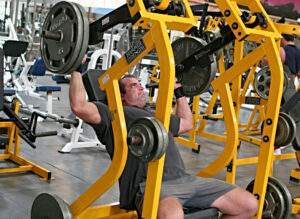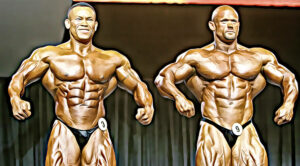
The Strength Sensei on Shoulder Training
Practical advice on building a great V-taper
In the early days of the Iron Game, bodybuilders often performed the same exercises as weightlifters, resulting in those physique champions being as strong as they looked. Consider two Iron Game legends, Bill Pearl and Tommy Kono.
Pearl won the 1971 NABBA Mr. Universe title, defeating former Mr. Olympia Sergio Oliva and future Mr. Olympia Frank Zane. Pearl reportedly could seated behind-the-neck press 310 pounds, bench press 450, and back squat 605. Weightlifter Kono won Olympic gold twice and set 22 world records. Along the way, he captured three amateur Mr. Universe titles. One of the characteristics of such cross-training was broad shoulders, creating the illusion of a smaller waist and an impressive V-taper.
Today, standing military presses have been replaced by the bench press as the go-to exercise for the average bodybuilder. The result of such emphasis is that the anterior (front) deltoids get overdeveloped, and the physique takes on a more blocky, less athletic appearance. The bench press is also the king of upper-body lifts in the strength and conditioning community.
The bench press is considered the universal standard for upper body strength. In the NFL, the bench press is the sole strength test in the NFL Combine. What’s odd is that the resistance is fixed, 225 pounds, the weight of a standard men’s Olympic bar and four 45-pound bumper plates. And the test is for maximum reps, making it more of a test of muscular endurance than power or absolute strength, particularly for linemen. Case in Point: The NFL Combine record is held by Eastern Kentucky defensive tackle Justin Ernest, setting the standard of 51 reps in 1999. Ernest was never drafted.
With that background, here are seven of the Strength Sensei’s best tips for shoulder training, particularly overhead presses:
- The deltoids contain primarily slow to immediate muscle fibers, responding best to higher reps.
- There is no single perfect deltoid exercise. You need a large training toolbox of exercises, performed from various body positions, to strengthen all areas of the strength curves of this muscle group.
 Perform a variety of exercises to develop the shoulders to their maximum girth.
Perform a variety of exercises to develop the shoulders to their maximum girth.
- Be conservative with the use of shoulder press machines, as excessive use can create a pattern overload that increases the risk of overuse injuries.
- Seldom should front raises be performed because the anterior deltoids are sufficiently worked with presses.
- Dumbbells should be preferred over barbells with deltoids, using a 2:1 ratio.
- A practical guideline to determine how much you should overhead barbell press is to take the weight you can military press with dumbbells, add 10 percent to the weight of each dumbbell, and multiply by two. You should also be able to perform a seated behind-the-neck press with 66 percent of what you can lift in a close-grip bench press.
- Use a split stance with performing overhead work to avoid arching the lower back.
And there you have it! Get to work, become as strong as you look, and develop, as the Strength Sensei was fond of saying, “Shoulders like Boulders!” (TSS)
– Photos by Miloš Šarčev
